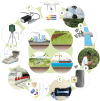Plant pest surveillance: from satellites to molecules
- PMID: 33720345
- PMCID: PMC8166340
- DOI: 10.1042/ETLS20200300
Plant pest surveillance: from satellites to molecules
Abstract
Plant pests and diseases impact both food security and natural ecosystems, and the impact has been accelerated in recent years due to several confounding factors. The globalisation of trade has moved pests out of natural ranges, creating damaging epidemics in new regions. Climate change has extended the range of pests and the pathogens they vector. Resistance to agrochemicals has made pathogens, pests, and weeds more difficult to control. Early detection is critical to achieve effective control, both from a biosecurity as well as an endemic pest perspective. Molecular diagnostics has revolutionised our ability to identify pests and diseases over the past two decades, but more recent technological innovations are enabling us to achieve better pest surveillance. In this review, we will explore the different technologies that are enabling this advancing capability and discuss the drivers that will shape its future deployment.
Keywords: biosecurity; diagnostics; phytopathology; surveillance.
© 2021 The Author(s).
Conflict of interest statement
The authors declare that there are no competing interests associated with the manuscript.
Figures






References
-
- United Nations. World Population Prospects: The 2015 Revision. 2015.
-
- Cassidy, E.S., West, P.C., Gerber, J.S. and Foley, J.A. (2013) Redefining agricultural yields: from tonnes to people nourished per hectare. Environ. Res. Lett. 8, 034015 10.1088/1748-9326/8/3/034015 - DOI
-
- Mumford, R.A., Macarthur, R. and Boonham, N. (2016) The role and challenges of new diagnostic technology in plant biosecurity. Food Secur. 8, 103–109 10.1007/s12571-015-0533-y - DOI
Publication types
MeSH terms
LinkOut - more resources
Full Text Sources
Other Literature Sources
Medical
Miscellaneous
